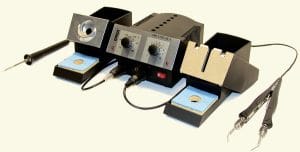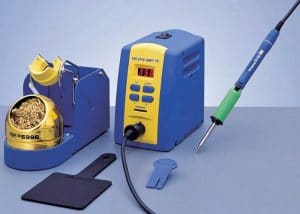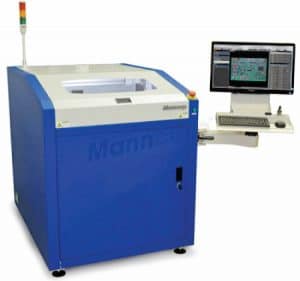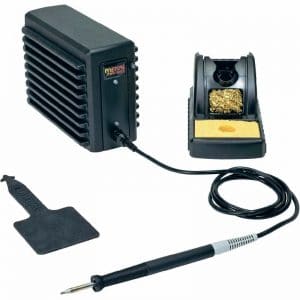 Soldering and desoldering stations cater to the various requirements of the electronics manufacturing industry. A soldering station is used for soldering electronic components on a PCB, and in some cases, it can also be utilised as a desoldering tool. Some soldering stations come with special desoldering extensions, simplifying overall operations.
Soldering and desoldering stations cater to the various requirements of the electronics manufacturing industry. A soldering station is used for soldering electronic components on a PCB, and in some cases, it can also be utilised as a desoldering tool. Some soldering stations come with special desoldering extensions, simplifying overall operations.
By Baishakhi Dutta
Soldering and desoldering stations have evolved over the years, in pace with technological advancements. They can be broadly categorised as rework stations, wave rework stations, BGA rework stations, SMD rework stations and PTH rework stations. Over the years, the technology and hardware design of these products have evolved to meet the growing demands of customers. Today, these machines are stringently tested for quality on the parameters of performance, operational fluency and construction specifications.
From carrying out simple soldering tasks to repairing and reworking surface-mount technology (SMT) boards, integrated circuits (ICs) and multi-layer boards, these stations are handy tools for every design engineer, technician, hobbyist or electronics enthusiast. Today, the soldering process is effectively carried out by machines. However, the repair work needs to be done by humans, and how well this is done depends on the specialist’s proficiency as well as the equipment used. Suitable for medium to high density soldering processes, diverse variants of these systems are available to meet the exact requirements of manufacturers.
Technology trends
Today, soldering stations come with innovative features to meet the requirements of small scale and complicated manufacturing. Advanced technologies offer soldering stations that have ultra-precise heating and temperature control systems, and are particularly designed for micro-soldering applications.
The different kinds of stations available
Soldering and desoldering stations are used for tasks that range from very minute straightforward jobs to heavy-duty applications. Based on the requirement and application, the different stations available vary in power consumption, temperature range, microcontroller (MCU) based controls and other features.
Contact soldering stations are the most common and popular. These have a built-in power supply unit, which, in most cases, ensures the galvanic separation between the power circuit and the heating element. Voltage on the heating element can be adjusted using the power supply unit and the heating temperature can be changed accordingly.
Lead-free soldering stations are another category that is used to wire lead-free printed circuit boards (PCBs). These usually make use of lead-free solders and are not necessarily expensive. With many developed nations mandating lead-free soldering, these stations could come in handy for future applications. They are specially designed to use lead-free solders, which offer good reliability and solderability.
Lead-free stations have their own share of problems such as requiring extra heat to melt the lead-free solder, which, in turn, affects the tip of the soldering iron. Most of the reputed manufacturers educate their buyers on the ideal usage practices of lead-free soldering stations, which helps them maintain and extend the life of soldering tips.
Soldering stations are also packaged with different kinds of heaters. Ceramic heaters, induction coil heaters and a combination of heater, sensor and soldering tip integrated into one tool are some other variations in soldering stations.
Hot-air rework and desoldering stations are generally used for removing components from PCBs and re-soldering new ones. While rework stations are ideal for simple jobs, desoldering stations are mostly used for demanding reworking on PCB boards and are comparatively less expensive.
Hot-air desoldering stations are ideal for professionals and hobbyists, because these can be used for preheating components before removing them or can be used on reflow SMT components such as dual inline packaging (DIP), small outline integrated circuits (SOICs), quad flat packages (QFPes) and other ICs.
Infrared (IR) soldering stations are the most advanced solutions for soldering complex elements. IR light helps prevent mechanical damage and the overheating of components because the radiation beam of the IR spectrum is sharply focused on the required point.
Tips to extend the life span of soldering and desoldering stations
Handling soldering and desoldering stations in the right manner is important to extend their life. Here are some tips on how you can do this:
- Validate each soldering process and set it to an optimum temperature, whereby the optimum soldering takes place. Avoid setting the highest possible temperature available in a soldering station.
- Thermal shock to the solder tip can be detrimental. Avoid excess water in the cleaning sponge, which results in a thermal shock to the solder tips. This practice extends the life of the solder tips.
- Do not tap the solder tip on the table or any hard surface.
- Do not try to sharpen the tips by rubbing or grinding them when they become blunt.
A plethora of options
From recent Chinese-made options to established brands, there are a variety of soldering and desoldering stations available in the market with a lot of interesting features. The application, budget and possible future uses are three important factors to consider before purchasing a station. PCBs are increasingly becoming lead-free today. Major manufacturers are now making use of lead-free solder components on boards. It could be beneficial in the long run to purchase a lead-free soldering station. Most stations designed for soldering leaded solders cannot be used for lead-free solders later; so, choose wisely.
Parameters to consider before buying a soldering station
Choosing the right kind of soldering station depends on a number of factors. A wide range of stations for various applications, with innovative features from numerous well-known brands, offering different levels of quality and at varying prices, all combine to leave buyers in a dilemma.
While price is an issue for buyers, one should make sure that quality is not compromised. Productivity and applicability should be major parameters while making a purchase decision. Chinese products flourishing in the Indian market is another cause for concern—not just for manufacturers but for buyers as well. Buyers are lured by the low prices of these soldering stations and later suffer on account of poor quality, while manufacturers have to compete with these imports on price and quality parameters.
Here are some more tips to choose the right kind of soldering and desoldering stations:
Choose a soldering station with a desoldering tool if you need to perform extensive repairs. Since these are expensive, and your budget may not cover this option, you could consider a simple soldering station with a desoldering copper braid.
Choose a soldering station with multiple tips of different sizes and shapes if you work on boards with different kinds of components. Electronic chips with a large number of pins require fine tips for soldering, while through-hole components can be soldered using thick tips. It is, therefore, a good idea to have tips of different sizes and types.
Choose a soldering station with temperature controls if you need to work on boards with different types of components and large ground planes. Since using excessive heat can damage a component, a temperature controlled soldering station should be the preferred choice.
Check the manufacturer’s reputation and ensure that after-sales support is offered as well.
Check for the availability of spare parts in the local market.
Always make a decision based on the quality rather than the price.
Interesting features and their benefits
Soldering and desoldering stations are a must-have for all electronics professionals. Nowadays, all stations are electrostatic discharge (ESD) safe, Restriction of Hazardous Substances (RoHS) compliant and digital in nature.
The new-age soldering station offers digital displays, digital calibration and password lock functions at a very competitive price. A recent development is the induction heating based hybrid soldering station. These stations incorporate the benefits of both technologies, IR heating and convection, to ensure the best in soldering.
Hot-air stations now come with built-in turbines for easy repair applications and heating processes such as shrinking. A brushless turbine is incorporated for the ideal flow of hot air so that the temperature is controlled electronically. Benchtop desoldering or rework stations have the most accurate temperature controls, best thermal recovery and additional features like programmable timing. Soldering stations come with soldering tips that incorporate Silver Line technology. These low-mass tips provide effective heat transfer via their silver core.
The unique closed-loop temperature control in some stations protects sensitive components. Most tips are available in three standard temperature ranges for maximum control. A ferro-magnetic sensor in the tip controls temperature; therefore, no adjustments are required.
A few products available in the market
HAKKO FX 951 soldering station
 The HAKKO FX 951 is a 75W digital soldering station. It has a good heat transfer and thermal recovery rate, and can be used in areas with high temperatures. The operating temperature range is between 200°C to 450°C. It has a compact vertical design, which increases the working space on the work bench. It comes with the HAKKO FM 2028 soldering iron. Optionally, you can use the HAKKO FM 2026, which is a N2 type of soldering iron. You can also use the HAKKO FM 2032, which is a micro soldering iron.
The HAKKO FX 951 is a 75W digital soldering station. It has a good heat transfer and thermal recovery rate, and can be used in areas with high temperatures. The operating temperature range is between 200°C to 450°C. It has a compact vertical design, which increases the working space on the work bench. It comes with the HAKKO FM 2028 soldering iron. Optionally, you can use the HAKKO FM 2026, which is a N2 type of soldering iron. You can also use the HAKKO FM 2032, which is a micro soldering iron.
Contact: www.hakko.com
MetroQ’s MTQ 917 soldering/desoldering station
 In this product, the soldering iron and the desoldering gun tool are controlled automatically by two microprocessors. The digital controls, the high-quality sensor and the heat exchange system guarantee
In this product, the soldering iron and the desoldering gun tool are controlled automatically by two microprocessors. The digital controls, the high-quality sensor and the heat exchange system guarantee
precise temperature control at the soldering tip. Temperature precision and optimal dynamic thermal behaviour under load conditions are obtained by the quick and accurate recording of the measured values in a closed control circuit, and this has been specially designed for lead-free production techniques. The high power and slim design makes this iron suitable for fine soldering work. The heating element is made of PTC, and the sensor on the soldering tip can control the soldering temperature quickly and accurately.
Contact: www.metroq.in
Manncorp’s IS-T-300 selective solder machine
 This is an all-in-one selective fluxing and soldering system designed to automate difficult or labour-intensive manual soldering. This soldering station offers advanced features like laser-controlled wave height compensation and high-precision jet-fluxing at a price point that ensures a quick return on investment. It handles boards up to 300mm x 300mm (11.8” x 11.8”) in a single pass or up to 300mm x 500mm (11.8” x 19.7”) in two passes.
This is an all-in-one selective fluxing and soldering system designed to automate difficult or labour-intensive manual soldering. This soldering station offers advanced features like laser-controlled wave height compensation and high-precision jet-fluxing at a price point that ensures a quick return on investment. It handles boards up to 300mm x 300mm (11.8” x 11.8”) in a single pass or up to 300mm x 500mm (11.8” x 19.7”) in two passes.
Contact: www.manncorp.com
Metcal’s MFR-1110
 The MFR-1110 single output series is highly versatile. It can be used with either a soldering tip, cartridge or tweezers, and offers a choice of four hand-pieces. The MFR-1110 comes with one cartridge soldering hand-piece, which uses small diameter cartridges for easy access and includes a full range of cartridges, including those required for SMD rework.
The MFR-1110 single output series is highly versatile. It can be used with either a soldering tip, cartridge or tweezers, and offers a choice of four hand-pieces. The MFR-1110 comes with one cartridge soldering hand-piece, which uses small diameter cartridges for easy access and includes a full range of cartridges, including those required for SMD rework.
Contact: www.okinternational.com/metcal





























